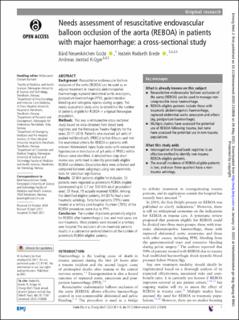| dc.contributor.author | Godø, Bård Neuenkirchen | |
| dc.contributor.author | Brede, Jostein Rodseth | |
| dc.contributor.author | Krüger, Andreas Jorstad | |
| dc.date.accessioned | 2022-04-05T06:44:07Z | |
| dc.date.available | 2022-04-05T06:44:07Z | |
| dc.date.created | 2021-06-06T08:30:31Z | |
| dc.date.issued | 2021 | |
| dc.identifier.citation | Emergency Medicine Journal. 2021, 26 1-6. | en_US |
| dc.identifier.issn | 1472-0205 | |
| dc.identifier.uri | https://hdl.handle.net/11250/2989749 | |
| dc.description.abstract | Background Resuscitative endovascular balloon occlusion of the aorta (REBOA) can be used as an adjunct treatment in traumatic abdominopelvic haemorrhage, ruptured abdominal aortic aneurysms, postpartum haemorrhage (PPH), gastrointestinal bleeding and iatrogenic injuries during surgery. This needs assessment study aims to determine the number of patients eligible for REBOA in a typical Norwegian population. Methods This was a retrospective cross-sectional study based on data obtained from blood bank registries and the Norwegian Trauma Registry for the years 2017–2018. Patients who received ≥4 units of packed red blood cells (PRBCs) within 6 hours and met the anatomical criteria for REBOA or patients with relevant Abbreviated Injury Scale codes with concurrent hypotension or transfusion of ≥4 units of PRBCs within 6 hours were identified. A detailed two-step chart review was performed to identify potentially eligible REBOA candidates. Descriptive data were collected and compared between subgroups using non-parametric tests for statistical significance. Results Of 804 patients eligible for inclusion, 53 patients were regarded as potentially REBOA eligible (corresponding to 5.7 per 100 000 adult population/year). Of these, 19 actually received REBOA. Among the identified eligible patients, 44 (83%) had a non-traumatic aetiology. Forty-two patients (79%) were treated at a tertiary care hospital. Fourteen (78%) of the REBOA procedures were due to PPH. Conclusion The number of patients potentially eligible for REBOA after haemorrhage is low, and most cases are non-traumatic. Most patients were treated at a tertiary care hospital. The exclusion of non-traumatic patients results in a substantial underestimation of the number of potentially REBOA-eligible patients. | en_US |
| dc.language.iso | eng | en_US |
| dc.publisher | BMJ Publishing Group | en_US |
| dc.rights | Navngivelse-Ikkekommersiell 4.0 Internasjonal | * |
| dc.rights.uri | http://creativecommons.org/licenses/by-nc/4.0/deed.no | * |
| dc.title | Needs assessment of resuscitative endovascular balloon occlusion of the aorta (REBOA) in patients with major haemorrhage: A cross-sectional study | en_US |
| dc.type | Peer reviewed | en_US |
| dc.type | Journal article | en_US |
| dc.description.version | publishedVersion | en_US |
| dc.source.pagenumber | 1-6 | en_US |
| dc.source.volume | 26 | en_US |
| dc.source.journal | Emergency Medicine Journal | en_US |
| dc.identifier.doi | 10.1136/emermed-2020-210808 | |
| dc.identifier.cristin | 1913925 | |
| cristin.ispublished | true | |
| cristin.fulltext | original | |
| cristin.qualitycode | 1 | |

